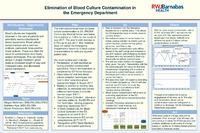Elimination of blood culture contamination in the emergency department
View File(s)
- Author(s)
- Details
-
Megan J. Martinson, BSN, RN, CEN, CPEN; Kathleen Nye, MSN, RN, CEN; Nicole Powasnick, MSN, RN, CEN
- Sigma Affiliation
- Non-member
Visitor Statistics
Visits vs Downloads
Visitors - World Map
Top Visiting Countries
| Country | Visits |
|---|
Top Visiting Cities
| City | Visits |
|---|
Visits (last 6 months)
Downloads (last 6 months)
Popular Works for Martinson, Megan by View
| Title | Page Views |
|---|
Popular Works for Martinson, Megan by Download
| Title | Downloads |
|---|
View Citations
Citations
Purpose: Blood cultures are frequently obtained in the care of patients with potentially serious infections to detect bacteremia. Blood culture contaminations are a common problem, particularly false-positive blood cultures. These are often the result of contamination from faulty aseptic techniques. This can lead to delays in proper treatment which leads to increased length of stay and increased costs, and decreased patient satisfaction. The international benchmark for blood culture contamination is 3%. This medical center is below this threshold at 1.28% for the month of July 2017. The year to date average is 0.75%. However, this does not satisfy the ED’s desire for 0 blood culture contaminations for superior patient care.
Design: This project was a joint effort with the laboratory and the ED, designed as a quality improvement project.
Setting: This community medical center is a 500+ bed community hospital in Toms River, New Jersey. Our project was based in the 80 bed emergency department.
Participants/Subjects: All ED staff who obtain blood culture specimens were included in this project. Any team member who obtained a contaminated specimen was involved in the remediation process.
Methods: Utilizing the PDCA method, we made small frequent cycles of change, including: remediation of staff who were identified as having a contaminated blood culture specimen (remediation involved demonstration of current technique, and teaching and return demonstration of proper technique); direct observation of real time blood culture specimen techniques and "just in time" education; weekly data from the laboratory with contaminated specimens; online learning module for all clinical ED staff; addition of blood culture collection techniques to annual mandatory education for all clinical staff.
Results/Outcomes: Blood culture contamination rates in this ED have decreased to 0.4% at the end of 2017.
Implications: Through strict adherence to policy, engagement of the team as to “the why” and remediation, blood culture contamination rates have decreased. Through continued efforts, we expect to be able to attain our goal of zero blood culture contaminations, which will improve the patient care and the patient experience in the ED. Close collaboration with the laboratory is necessary for this process to work, as nearly real time data brings home the message for the team members involved in the specimen collection process.
Emergency Nursing 2018. Held at David L. Lawrence Convention Center, Pittsburgh, Pennsylvania, USA
| Type | Poster |
| Acquisition | Proxy-submission |
| Review Type | Abstract Review Only: Reviewed by Event Host |
| Format | Text-based Document |
| Evidence Level | N/A |
| Research Approach | N/A |
| Keywords | Blood Culture Contamination; Blood Cultures; Emergency Department |
| Name | Emergency Nursing 2018 |
| Host | Emergency Nurses Association |
| Location | Pittsburgh, Pennsylvania, USA |
| Date | 2018 |
All rights reserved by the author(s) and/or publisher(s) listed in this item record unless relinquished in whole or part by a rights notation or a Creative Commons License present in this item record.
All permission requests should be directed accordingly and not to the Sigma Repository.
All submitting authors or publishers have affirmed that when using material in their work where they do not own copyright, they have obtained permission of the copyright holder prior to submission and the rights holder has been acknowledged as necessary.
Related items
Showing items related by title, author, creator and subjects.
-
Blood culture contamination in the emergency department
Winters, Sharon; McClure, Patricia (2017-12-05)Purpose: Current best practice for collecting blood cultures is to divert the first 1-2ml of blood, so to send the micro-organisms away from the blood culture tubes that will be tested. Residing in the deeper dermis layer ... -
ER pilot leads to hospital-wide implementation of blood culture device
Stonecypher, Karen; Noble, JenniferSession G presented Friday, September 28, 1:00-2:00 pm Purpose: Blood culture (BC) collection plays a primary role in the diagnosis of infections. False-positive cultures can lead to unnecessary antibiotic treatment, ... -
Providing nasal naloxone spray to high risk emergency department patients
Kobelt, Paula; Ashley, Benjamin; Nye, Kimberly; Huff, Pamela; Harbaugh, Lisa (2017-12-05)Poster presentation, Session E presented Friday, September 15, 2017 Purpose: To address knowledge gaps and negative attitudes towards patients with substance use disorders (SUDs) and to collect information to inform a ... -
Goal zero: Eliminating mislabeled specimens in the emergency department
Samsa, Michele; Henderson, TracieThis emergency department (ED) noticed an increase in misidentified laboratory specimens noted to be the highest in our hospital region. Misidentified specimens can result in misdiagnosis, medication errors and repeat ... -
Lived experiences of emergency department nurses during the COVID-19 Pandemic: What we have learnt and how we can plan for the future
Simic, Megan (Sigma Theta Tau International, 2023-06-01)Understanding the feelings, perceptions and attitudes of emergency department (ED) nurses who worked on the frontline during the COVID-19 pandemic is essential for the growth and resilience of the healthcare workforce. ...





